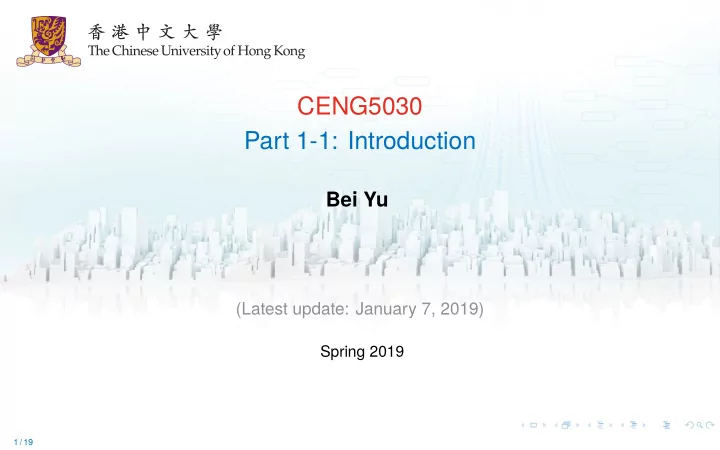

CENG5030 Part 1-1: Introduction Bei Yu (Latest update: January 7, 2019) Spring 2019 1 / 19
Question Why Energy Efficient Computing? Question In computing, where the energy consumption comes from? 2 / 19
Overview Background: Digital Logic Power Modeling Power Reduction: First Glance 3 / 19
Overview Background: Digital Logic Power Modeling Power Reduction: First Glance 4 / 19
Digital Logic ◮ Digital logic circuits operate on logical values, represented by voltage ranges. 5.0 V Logic 0 Logic 1 HIGH (1) 4.0 V False True 3.0 V Off On LOW HIGH 2.0 V No Yes LOW (0) 1.0 V Open Closed switch switch 0.0 V ◮ Voltages between ground and a certain threshold represent the logical value 0. ◮ Voltages between a higher threshold and VDD represent the logical value 1. ◮ The threshold levels are design choices. ◮ If a voltage falls in the gap between the defined logical ranges, the result is undefined and there must be an error in the logic circuit that produced it. 4 / 19
MOSFET Approximations MOSFETs can be approximated as either open or short circuits between drain and source. 5 / 19
CMOS Logic Circuits ◮ CMOS logic circuits consist of complementary arrangements of NMOS and PMOS transistors. ◮ A CMOS circuit is reliable because its design guarantees that its output is always shorted to either ground or VDD but not both at the same time. ◮ As a consequence, the design also ensures that VDD is never shorted to ground through Z, which makes CMOS circuits power-efficient. (a) Bad Design 1 (b) Bad Design 2 6 / 19
Logic Gates OR NOT (Invertor) AND NAND NOR XOR XNOR 7 / 19
Logic Gates OR NOT (Invertor) AND NAND NOR XOR XNOR Question: What is the schematic view of an AND gate? 7 / 19
Question: Please draw NOR gate schematic view. 8 / 19
Overview Background: Digital Logic Power Modeling Power Reduction: First Glance 9 / 19
Dynamic Power Dynamic Power Modeling P ∝ C · V 2 · A · f ◮ C : total capacitance seen by the gate’s outputs ◮ V : supply voltage ◮ A : activity of the gates in the system ◮ f : frequency of the system’s operation 9 / 19
Dynamic Power Dynamic Power Modeling P ∝ C · V 2 · A · f ◮ C : total capacitance seen by the gate’s outputs ◮ V : supply voltage ◮ A : activity of the gates in the system ◮ f : frequency of the system’s operation Question: What’s the most effective way to reduce dynamic power consumption? 9 / 19
Static (Leakage) Power The power dissipated by a transisotr whose gate is intended to be off. Static Power Modeling P ∝ V · I leak I leak ∝ exp ( − q · V th ) ◮ V th : threshold voltage ◮ Minimum gate-to-source voltage that is needed to create a conducting path between the source and drain terminals ◮ Click here for an animation of threshold voltage. 10 / 19
Compensation of Voltage Scaling f max ∝ ( V − V th ) 2 V ◮ Maximum frequency is roughly linear in V ◮ Voltage should be larger than threshold voltage 11 / 19
Compensation of Voltage Scaling f max ∝ ( V − V th ) 2 V ◮ Maximum frequency is roughly linear in V ◮ Voltage should be larger than threshold voltage ◮ Motivation of parallel computing Apple A11 chip, in 2017. 11 / 19
Recommend
More recommend